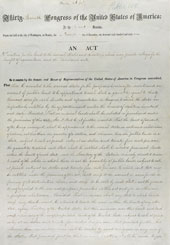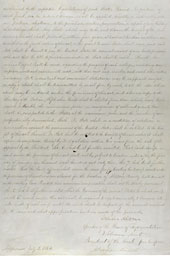Morrill Act to be featured in rare ISU exhibit
03-13-08
Contacts:
Allison Sheridan, University Museums, (515) 294-4442, aclone@iastate.edu
Carole Custer, University Marketing, (515) 294-3134, cacuste@iastate.edu
Mike Ferlazzo, News Service, (515) 294-8986, ferlazzo@iastate.edu
Anne Kassel, News Service, (515) 294-6881, akassel@iastate.edu
Morrill Act to be featured in rare ISU exhibit
AMES, Iowa -- The Morrill Act, which established land-grant universities nationwide, is one of the most significant documents in Iowa State University history. So maybe it's appropriate that the document, which was signed by President Abraham Lincoln in 1862 and has never been seen outside of Washington, D.C., will be featured in an ISU exhibit that opens on Saturday, March 22 -- the date celebrating the university's 150th birthday.
Iowa State was established by the Iowa legislature on March 22, 1858. Four years later, Lincoln signed the Morrill Act, creating a new kind of university called a "land-grant." The state of Iowa eagerly signed on and Iowa State became a leader in the shaping the land-grant university, also known as the "people's college."
The exhibition, "The Morrill Act of July 2, 1862: The Land-grant Act and the People's College," will be available for viewing in Morrill Hall's Christian Petersen Art Museum. The exhibit will also include historical ISU pictures and artifacts, educational programs for students in an 1870s style classroom as well as the full history of Iowa State's 150 years.
Bringing the Morrill Act to campus was not an easy task, particularly since it hasn't been publicly viewed since 1979. Planning began a year and a half ago when ISU officials contacted the National Archives and Records Administration. Following an inspection by a federal government employee, Morrill Hall was confirmed as a secure site and granted permission to display the document.
Due to its fragility and sensitivity, the 146-year-old document requires a concealed delivery, special lighting, strict environmental controls, 24-hour security and a museum-accredited display case.
"We knew it would be difficult to obtain the document, but we chose the Morrill Act for the exhibition because we wanted to illustrate the roots of Iowa State and its 150th birthday," said Allison Sheridan, University Museums exhibit coordinator. "We hope this unprecedented exhibit enlightens Iowa Staters."
Iowa State was founded when Iowa Gov. Ralph Lowe signed the legislative act establishing a higher educational institution with courses focusing on agriculture and the mechanical arts. The Iowa Agricultural College and Model Farm was established on the land west of Ames.
The signing of the Morrill Act brought higher education to the federal level in the United States by requiring courses in agriculture, mechanical arts, military tactics and liberal arts and sciences without discriminating against gender, race or wealth. When the federal government presented the act to state legislatures, Iowa was the first state to approve the provisions as it had already developed its own agricultural based college with a mission similar to that of the Morrill Act. The Iowa Agricultural College and Model Farm was then established as the state's land-grant university.
As Iowa State celebrates its 150th birthday -- highlighting its year-long sesquicentennial celebration -- Director of University Marketing Carole Custer sees great significance in the exhibition.
"Iowa State is delighted that University Museums has taken this exhibit on as a way to communicate one of the largest milestones that gave even more focus to this university's purpose," said Custer. "This monumental exhibition is an opportunity for Iowans to see the groundbreaking legislation that has impacted Iowa State's success throughout history."
The exhibit, open through April 27, is sponsored by the ISU Foundation and University Museums and is free of charge to the public. Exhibit hours are 9 a.m. to 4 p.m. weekdays and 1 to 4 p.m. on weekends, with special Veishea hours on Saturday, April 12, from 9 a.m. to 4 p.m. Additional details are available at http://www.museums.iastate.edu/.
-30-

